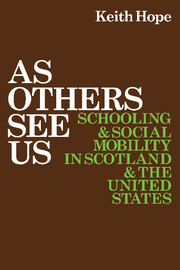Book contents
- Frontmatter
- Contents
- Acknowledgments
- Introduction
- 1 Scotland: A meritelective system?
- 2 Comparison of Scotland with England and Wales
- 3 Comparison of Scotland with the United States
- 4 IQ + effort = merit
- 5 The institutions of managed meritelection
- 6 Was selection carried out fairly?
- 7 Meanings of key terms
- 8 Does deprivation affect life chances?
- 9 Market situation
- 10 Intelligence and occupational mobility
- 11 Intelligence and vertical mobility
- 12 Scottish society
- 13 Understanding other people's norms
- 14 Merit or desert?
- Notes
- References
- Index
2 - Comparison of Scotland with England and Wales
Published online by Cambridge University Press: 05 February 2012
- Frontmatter
- Contents
- Acknowledgments
- Introduction
- 1 Scotland: A meritelective system?
- 2 Comparison of Scotland with England and Wales
- 3 Comparison of Scotland with the United States
- 4 IQ + effort = merit
- 5 The institutions of managed meritelection
- 6 Was selection carried out fairly?
- 7 Meanings of key terms
- 8 Does deprivation affect life chances?
- 9 Market situation
- 10 Intelligence and occupational mobility
- 11 Intelligence and vertical mobility
- 12 Scottish society
- 13 Understanding other people's norms
- 14 Merit or desert?
- Notes
- References
- Index
Summary
In Chapter 1 we looked at two societies that lay claim to the virtue of being in some degree “meritocratic” or “meritelective.” The obvious question which a comparison between these two countries poses is this: Where does England stand vis-à-vis either of them? More especially, how does England (or rather, England and Wales, since educational law is common to both those entities) compare with Scotland? Although the question is obvious and indeed pressing, the answer is not at all easy to arrive at. English educational practice is as murky as English educational history is complex.
Educational policy
In a nutshell, the history of public education in England consists in a move from religion to class as the determinant of administrative arrangements. And the people who presided over that process, and bent their efforts to promoting it, were a small group of radical policy makers. Prominent among them were R. H. Tawney and Charles Philips Trevelyan. In this respect, Scotland was ahead of England. Writing to Bertrand Russell in 1929, C. P. Trevelyan (who was then for the second time president of the Board of Education in a Labour administration) said:
I am absolutely determined that the Labour party shall not get into the hands of any religion. … I want a better solution if I can get it. My anchor is the appointment of teachers. If I could get that into the hands of the public I would concede a great deal in other directions. […]
- Type
- Chapter
- Information
- As Others See UsSchooling and Social Mobility in Scotland and the United States, pp. 35 - 45Publisher: Cambridge University PressPrint publication year: 1985



